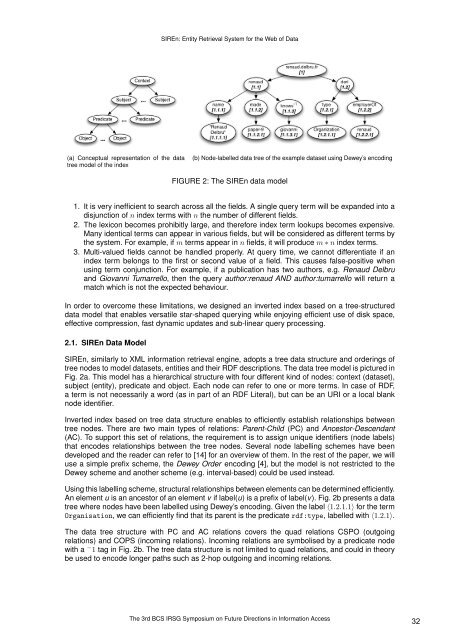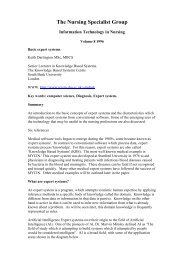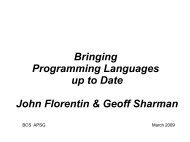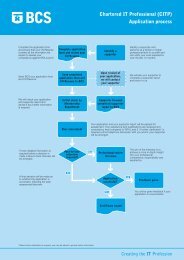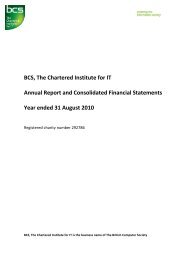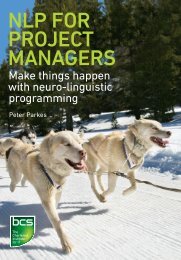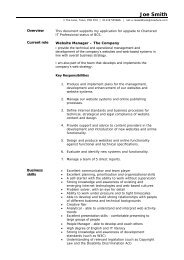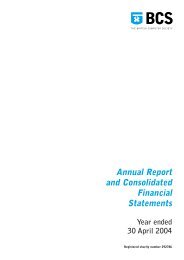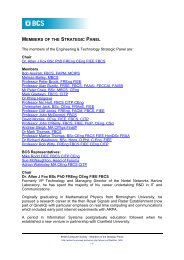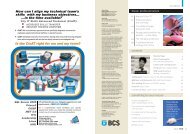SIREn: Entity Retrieval System for the Web of Data - BCS
SIREn: Entity Retrieval System for the Web of Data - BCS
SIREn: Entity Retrieval System for the Web of Data - BCS
- TAGS
- entity
- retrieval
- www.bcs.org
You also want an ePaper? Increase the reach of your titles
YUMPU automatically turns print PDFs into web optimized ePapers that Google loves.
(a) Conceptual representation <strong>of</strong> <strong>the</strong> data<br />
tree model <strong>of</strong> <strong>the</strong> index<br />
<strong>SIREn</strong>: <strong>Entity</strong> <strong>Retrieval</strong> <strong>System</strong> <strong>for</strong> <strong>the</strong> <strong>Web</strong> <strong>of</strong> <strong>Data</strong><br />
(b) Node-labelled data tree <strong>of</strong> <strong>the</strong> example dataset using Dewey’s encoding<br />
FIGURE 2: The <strong>SIREn</strong> data model<br />
1. It is very inefficient to search across all <strong>the</strong> fields. A single query term will be expanded into a<br />
disjunction <strong>of</strong> n index terms with n <strong>the</strong> number <strong>of</strong> different fields.<br />
2. The lexicon becomes prohibitly large, and <strong>the</strong>re<strong>for</strong>e index term lookups becomes expensive.<br />
Many identical terms can appear in various fields, but will be considered as different terms by<br />
<strong>the</strong> system. For example, if m terms appear in n fields, it will produce m ∗ n index terms.<br />
3. Multi-valued fields cannot be handled properly. At query time, we cannot differentiate if an<br />
index term belongs to <strong>the</strong> first or second value <strong>of</strong> a field. This causes false-positive when<br />
using term conjunction. For example, if a publication has two authors, e.g. Renaud Delbru<br />
and Giovanni Tumarrello, <strong>the</strong>n <strong>the</strong> query author:renaud AND author:tumarrello will return a<br />
match which is not <strong>the</strong> expected behaviour.<br />
In order to overcome <strong>the</strong>se limitations, we designed an inverted index based on a tree-structured<br />
data model that enables versatile star-shaped querying while enjoying efficient use <strong>of</strong> disk space,<br />
effective compression, fast dynamic updates and sub-linear query processing.<br />
2.1. <strong>SIREn</strong> <strong>Data</strong> Model<br />
<strong>SIREn</strong>, similarly to XML in<strong>for</strong>mation retrieval engine, adopts a tree data structure and orderings <strong>of</strong><br />
tree nodes to model datasets, entities and <strong>the</strong>ir RDF descriptions. The data tree model is pictured in<br />
Fig. 2a. This model has a hierarchical structure with four different kind <strong>of</strong> nodes: context (dataset),<br />
subject (entity), predicate and object. Each node can refer to one or more terms. In case <strong>of</strong> RDF,<br />
a term is not necessarily a word (as in part <strong>of</strong> an RDF Literal), but can be an URI or a local blank<br />
node identifier.<br />
Inverted index based on tree data structure enables to efficiently establish relationships between<br />
tree nodes. There are two main types <strong>of</strong> relations: Parent-Child (PC) and Ancestor-Descendant<br />
(AC). To support this set <strong>of</strong> relations, <strong>the</strong> requirement is to assign unique identifiers (node labels)<br />
that encodes relationships between <strong>the</strong> tree nodes. Several node labelling schemes have been<br />
developed and <strong>the</strong> reader can refer to [14] <strong>for</strong> an overview <strong>of</strong> <strong>the</strong>m. In <strong>the</strong> rest <strong>of</strong> <strong>the</strong> paper, we will<br />
use a simple prefix scheme, <strong>the</strong> Dewey Order encoding [4], but <strong>the</strong> model is not restricted to <strong>the</strong><br />
Dewey scheme and ano<strong>the</strong>r scheme (e.g. interval-based) could be used instead.<br />
Using this labelling scheme, structural relationships between elements can be determined efficiently.<br />
An element u is an ancestor <strong>of</strong> an element v if label(u) is a prefix <strong>of</strong> label(v). Fig. 2b presents a data<br />
tree where nodes have been labelled using Dewey’s encoding. Given <strong>the</strong> label 〈1.2.1.1〉 <strong>for</strong> <strong>the</strong> term<br />
Organisation, we can efficiently find that its parent is <strong>the</strong> predicate rdf:type, labelled with 〈1.2.1〉.<br />
The data tree structure with PC and AC relations covers <strong>the</strong> quad relations CSPO (outgoing<br />
relations) and COPS (incoming relations). Incoming relations are symbolised by a predicate node<br />
with a − 1 tag in Fig. 2b. The tree data structure is not limited to quad relations, and could in <strong>the</strong>ory<br />
be used to encode longer paths such as 2-hop outgoing and incoming relations.<br />
The 3rd <strong>BCS</strong> IRSG Symposium on Future Directions in In<strong>for</strong>mation Access<br />
32


